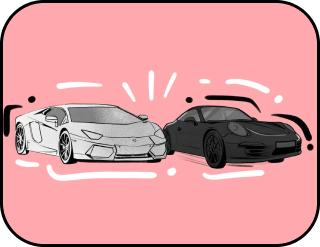Real-world tech behind movie magic
“Cinema is a way to enter another world, where you have the opportunity to see, feel, and experience things that are usually out of reach.”
Steven Spielberg
How quickly the minutes fly by while watching a great movie! The lights in the theater dim, and suddenly we are sailing across stormy ocean waves, skillfully evading a chase on winding roads, sharing emotions with the characters, and quite literally finding ourselves at the very center of an exciting story.
Directors have always strived to convey their vision to the audience as fully as possible. Every filmmaker dreams that their movie will completely capture the viewers’ attention, transport them into their own world, and, most importantly, allow them to feel everything happening on screen.
Some studies have shown that during scenes involving cold water in the movie Titanic, viewers actually experienced a sensation of cold. They became so absorbed in the final part of the film that they even forgot they were simply watching a movie in a theater and didn’t need to find a free seat in a lifeboat to escape the sinking liner.
In other words, people literally transported themselves into the story of the film and experienced all the emotions of the main characters. But how does this immersion happen? Directors have many secrets and techniques that help turn ordinary frames into real adventures — and one of them is special effects.
Special effects are a powerful tool that helps creators bring their boldest scenarios to life. They make a film more thrilling, capture the audience’s attention, and have a strong impact on them. The creation of special effects is a painstaking process that requires the efforts of a large team and serious scientific knowledge.
Pioneers of Special Effects
Special effects are quite an old phenomenon. They appeared long before computer graphics, and even more so before artificial intelligence. They were born alongside cinema itself and developed hand in hand with it: while audiences were still reeling from the excitement caused by the first motion picture by the Lumière brothers, directors were already thinking about how to astonish them once again.
The first semblance of a special effect appeared in the short film The Execution of Mary Stuart directed by Alfred Clark. The film premiered in August 1895. It lasted only 21 seconds and consisted of a single scene — the execution of Queen Mary. The audience was simultaneously shocked and thrilled by what they saw: many believed that a real person’s head had been cut off for the filming. But in reality, Clark used a stop-motion technique, replacing the living actress with a mannequin.
The father of special effects is considered to be the French illusionist and director Georges Méliès. From a young age, the future pioneer of special effects was fascinated by the art of magic tricks, and the world of cinema became a new opportunity for him to create illusions on an entirely different scale.
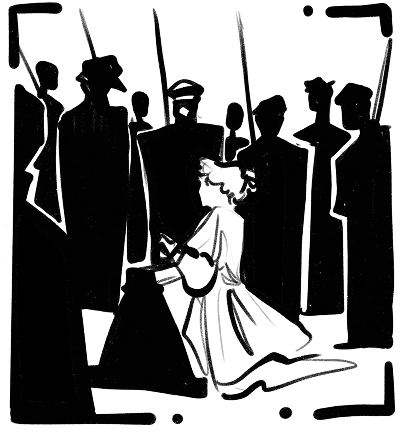
On September 1, 1903, France witnessed the first science fiction film in the history of cinema — A Trip to the Moon by Georges Méliès. In his film, he used several special effects he had developed himself: stop-motion, dissolves, double exposure, slow motion and accelerated filming, as well as frame-by-frame shooting. There were even times when special effects were born by accident: for example, the stop-motion effect was discovered by chance during a camera malfunction. What we now consider completely ordinary caused a sensation among audiences at the time and forever changed the world of cinema.
Another important film that influenced the development of special effects in the early 20th century was Metropolis, directed by Fritz Lang and released in 1927. This dystopian film was the first to use the Schüfftan Process. This technique was developed by the film’s cinematographer, Eugen Schüfftan. He suggested combining different parts of a scene using a mirror. The mirror was placed at a 45-degree angle to the camera and reflected models or drawings positioned next to the camera (at a 90-degree angle to it). Part of the mirror’s reflective coating was scraped away so that only clear glass remained in those areas. Through this clear section, other miniatures or actors standing against the decorations could be seen. In this way, the camera would film a seamlessly combined scene in real time.
Almost all of the set pieces in the film were miniatures, which had never been used in cinema before. This became one of the very first examples of using optical illusions in filmmaking.
Along with the advancement of science, the special effects in cinema also evolved. People wanted to travel into space, to see the Mariana Trench, to sail on a ship with cheerful pirates, and to rescue a princess from a dragon — and directors were more than happy to bring people’s wishes and their own dreams to life. They realized that knowledge of disciplines such as physics and chemistry could help bring even the wildest scenarios to reality. It is precisely for this reason that cinema, starting from its launching point in the form of A Trip to the Moon, was able to reach Avatar in just under two hundred years.
But what does physics have to do with it?
When watching a good movie, we become so immersed in the story that we hardly stop to wonder how it’s possible that a car came to a sudden stop just a couple of centimeters from the main character. Or how, in the beloved trilogy, old Gandalf appears almost twice as tall as the hobbits.
We might be tempted to call it magic — but fortunately, for such special effects, there’s another name: physics!
Optics and Light
Cinema is probably one of those very cases when you shouldn’t trust your own eyes, because nothing is quite what it seems.
Bending lines, flipping perspectives, playing with symmetry and angles, doing everything to make the ordinary appear unusual — these techniques have long existed in the film industry, and optics help bring them to life.
Optics is a branch of physics that studies optical radiation (light in its broadest sense), its propagation, and its behavior when interacting with various surfaces. This field of science helps directors create those very illusions on screen that make the audience believe in what’s happening: illusions of movement, changes in the shape of objects, their size, volume, and depth.
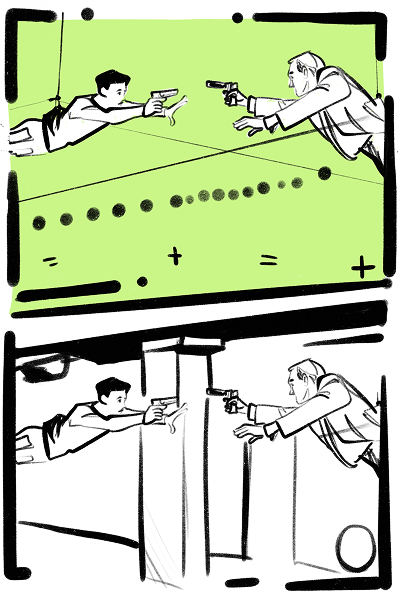
Optics in cinema is also inseparably connected with the perspective of shooting. Perspective allows the image on the screen to appear voluminous and deep. It gives life to a flat picture, pushing it closer to or farther away from the viewer. In other words, it’s crucial for technical specialists to calculate how to frame a shot and set up lighting in order to convey to the audience exactly the image they intended.
The use of optical knowledge in filmmaking began with the earliest developments of special effects. Forced perspective is one of the earliest special effects techniques that employs optical illusion to make an object appear farther away, closer, larger, or smaller than it actually is. This technique manipulates visual perception through scaled objects, the proportions between them, and the viewer’s point of view.
It was precisely through optics and perspective that, in one of the scenes from the first part of The Lord of the Rings trilogy — the scene where Frodo and Gandalf sit at a table — we see a significant difference in their height. The secret lies in a specially designed table and the careful positioning of the actors in front of the camera.
And in the first Pirates of the Caribbean film, no one actually blew up a real ship. Of course, real ships were involved in the filming, but it would have been far too expensive to destroy them. For such scenes, special miniatures of different sizes were made, which were blown up under carefully arranged lighting and shooting perspectives. And you’ll agree — on screen, it’s completely impossible to tell that the ships aren’t real.
There is another special effect — background replacement. Filmmakers began changing backgrounds at the beginning of the last century: initially, glass panels with the required image were placed behind the actors, as seen in the film Mission California (1907).
With the advent of projectors, the background was projected onto a transparent screen behind the actors — this made it possible for the background to be dynamic. This type of special effect is called rear projection. Rear projection helps transport actors to the desired location or make action scenes safer.
Today, this special effect is rarely used: it’s primarily employed to convey the atmosphere of a film and make a reference to the classics of cinema. For example, in Pulp Fiction, Tarantino used rear projection behind a stationary car — an image of the road was projected onto a screen behind the actors sitting in the car.
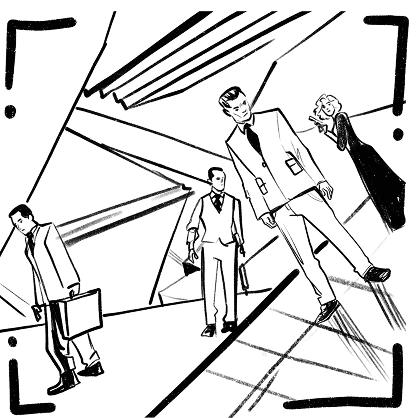
Speaking of optical illusions, we can’t overlook Christopher Nolan’s film Inception. In it, Nolan literally redefines space to immerse the viewer in the world of the characters’ lucid dreams. The film almost completely avoids computer graphics and instead uses practical special effects. For example, the Penrose staircase is featured. The scene was shot live, without the use of computer graphics, but with the application of great science. At the beginning of the scene, we see the structure from above, an “endless” series of steps. Then, the angle shifts, and the illusion falls apart.
Science makes it possible to film in places on our planet that are practically inaccessible. The ascent in the film Everest was, of course, not filmed on the actual mountain. The shots of the summit were filmed in a studio, and the lighting was crucial to creating a sense of reality. All ascents to the highest point on Earth happen only at certain times of the day. The technical and filming teams had to create such lighting in the studio and carefully select the shots to ensure that viewers had no doubt that what they were seeing on screen was the very summit itself.
Theoretical Mechanics
But it’s not just optics that helps us dive into the unexplored worlds of films. In order for what happens in a movie to appear as realistic as possible, a team of technicians and special effects experts determine the trajectories of movements for each object on screen, in order to bring them together into a cohesive, believable picture. Even when working with 3D animation, dynamics and mechanics are essential.
Dynamics studies the laws of motion and helps us understand how objects will move and change under various conditions. The shape of the object and the material it’s made of are particularly important, as these factors influence its movement.
For instance, rigid body mechanics helps determine how objects interact with each other in space. This is crucial for creating realistic collisions and both elastic and inelastic interactions. When creating action scenes, it’s important to consider the physics of impacts and the characters’ reactions.
When calculating car collisions in films, the laws of rigid body dynamics and the interactions between components and materials are taken into account.
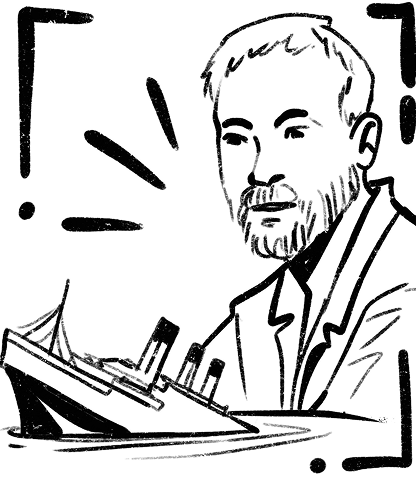
For example, in the film The Man with the Golden Gun (1974), for the car chase scene involving James Bond and a car flip, aeronautics and flight physics expert Raymond McHenry developed a special program called HVOSM. This program allowed the scene to be drawn on a computer, recreating all the terrain features and calculating the angle of the car’s takeoff and landing. Thanks to this, the director and film crew understood how the action would unfold in the scene.
Before filming the shipwreck in Titanic, the film crew, led by director James Cameron, conducted several experiments on a model of the ship to understand how it should sink under the given conditions. First, calculations were loaded into a special program that simulated the disaster, and then it was recreated live using the model and explosives.
Of course, they didn’t have to do this, since there were almost no witnesses left of the actual disaster, and no one could say for sure what had happened. But Cameron wanted to get as close to reality as possible, so he turned to science and spent a considerable amount of time on calculations.
Explosions also involve complex physical calculations, which are carried out in several stages. It is important to calculate the force, direction, and timing of the explosion. For the realism of the event, technical experts must understand the pressure and the length of the shockwave. The audience is unlikely to believe it if, after an explosion, people in the shot who were dangerously close to it continue with their activities as if nothing happened.
Often, the calculations help determine how to implement the planned special effect during filming: how to reinforce a car, what mechanisms to place inside it to ensure the intended effect appears on screen.
In Fast & Furious 6, the stunts involving car flips were filmed live using a pneumatic device powered by compressed nitrogen. The so-called “nitrogen cannon” was installed behind the driver’s seat, with a safety cage welded into the car’s frame and a hole made in the chassis for the firing mechanism of the device.
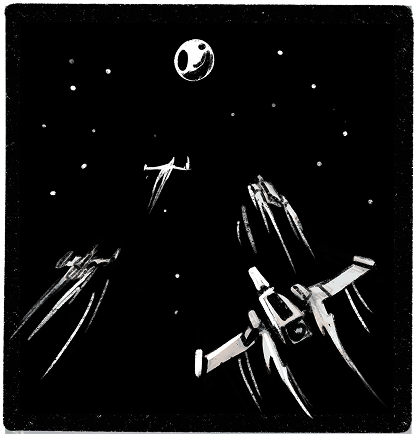
But sometimes directors have to create new technologies to bring their ideas to life. When preparing to shoot the first film in the Star Wars saga, George Lucas realized that he wouldn’t be able to achieve his vision using existing technologies. He gathered a team of model makers, mechanics, and artists and founded a digital visual effects and computer graphics studio. The team created over 365 special effects for the film. Their most significant invention was the motion control system for the camera.
Previously, when filming vehicles, the models of objects were moved relative to a stationary camera, which made it difficult for directors to shoot miniature spacecraft from different angles. Thanks to science, filmmakers were now able to showcase spacecraft in all their glory. The models of the ships remained stationary, while the camera, frame by frame, followed a pre-programmed trajectory. Today, it’s hard to imagine a film set without these technologies. It’s even frightening to think about how boring or ridiculous films would be if people didn’t understand the laws of physics.
Chemistry in Cinema
Chemistry, as a science, has also had a significant impact on cinematography, as many special effects would be impossible without it.
Various natural phenomena on screen, such as fire and fog, are created in different ways. For modeling rising steam waves, a solution of dry ice in water is often used. The color of the flame is determined by the temperature and the chemicals that are burning in it. In films, chemical green fire is often used, but other colors can be created as well. Cold fire — a type of low-temperature flame — is also frequently used in cinema. This kind of flame is produced by burning complex organic and inorganic ethers, such as ethyl ether of boric acid.
Without fake blood, we would never have those shocking scenes. However, to create blood scenes, directors don’t always use chemical compositions; sometimes they use other alternative substances that resemble blood in color and texture.

A very interesting example of the use of science in cinema is shown in the TV series Peaky Blinders. The lead actor, Cillian Murphy, does not smoke, but his character never lets go of his cigarette. For the filming, cigarettes without nicotine were used, made from herbs. They looked natural and didn’t harm health. This became a perfect example of science in action: chemistry and biology in one bottle!
Animation and Simulation
Since the late 20th century, special effects in cinematography have gradually been replaced by visual effects, which are created using computer graphics (CGI – Computer-Generated Imagery). This technology allows for the creation of complex and realistic visual effects: explosions, space scenes, fantastic creatures, and much more. In the production of CGI animation, dynamics and mechanics are used to simulate the movement of objects and include the simulation of liquids, smoke, fabrics, and other materials.
By the way, simulating liquids is one of the most complex tasks in computer graphics. For this, physical models and even equations are applied. For example, the Navier-Stokes equations are used to model flows, waves, and the interaction of water with the environment. In the same film, Titanic, large-scale water simulation was used for the first time. It turned out to be quite realistic, didn’t it?
Simulating fire is also based on physics and requires various approaches. For example, using equations of state for gases, temperature changes and the density of combustible gases are modeled.
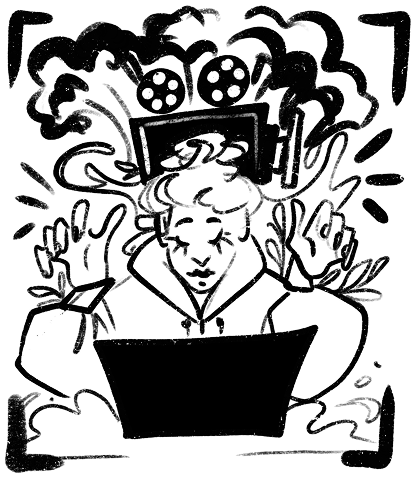
To simulate smoke, it is necessary to model complex interactions between gases and the environment — using fluid dynamics computation methods, realistic smoke clouds are created.
In computer graphics, particle systems are used. These systems are based on physical principles and allow animators to predict the behavior of large numbers of small objects, which makes the effects more realistic.
Cinematographic technologies have advanced so much that viewers are now finding it difficult to understand where computer graphics are used in a film and what was shot live. However, directors’ opinions on this matter are divided. Computer graphics simplify the process of creating special effects and save movie studios’ budgets; they are also the safest option for actors and stunt performers. But most directors choose to combine practical effects and CGI animation, because such a tandem guarantees full immersion of viewers into any film.
Special effects are perhaps the most obvious manifestation of the scientific and technical aspects of cinematography. Despite the advancement of computer graphics and artificial reality, physics and chemistry still play a crucial role in creating blockbusters. Thanks to them, new filming technologies continue to emerge, and new effects are created that stir our consciousness.
The collaboration of scientists and film studios, from time immemorial, has allowed humanity to fully immerse itself in films, feel them with every cell of our bodies, and believe that anything is possible!
Your thought is a big bang of ideas. Our journal is its source.
Thank you!



